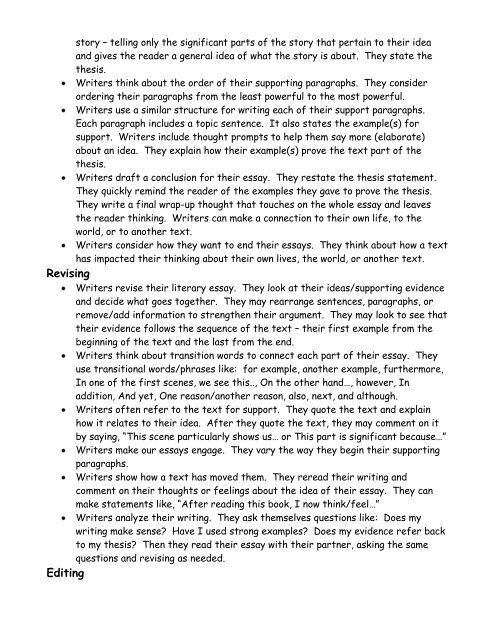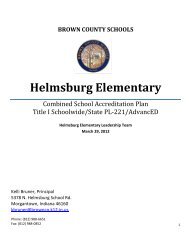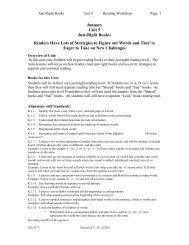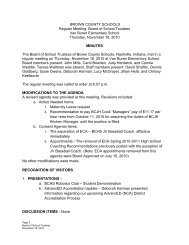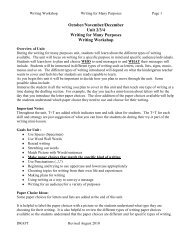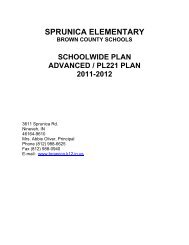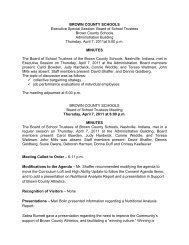Grades 5 and 6 Writing Units of Study.pdf
Grades 5 and 6 Writing Units of Study.pdf
Grades 5 and 6 Writing Units of Study.pdf
Create successful ePaper yourself
Turn your PDF publications into a flip-book with our unique Google optimized e-Paper software.
story – telling only the significant parts <strong>of</strong> the story that pertain to their idea<br />
<strong>and</strong> gives the reader a general idea <strong>of</strong> what the story is about. They state the<br />
thesis.<br />
Writers think about the order <strong>of</strong> their supporting paragraphs. They consider<br />
ordering their paragraphs from the least powerful to the most powerful.<br />
Writers use a similar structure for writing each <strong>of</strong> their support paragraphs.<br />
Each paragraph includes a topic sentence. It also states the example(s) for<br />
support. Writers include thought prompts to help them say more (elaborate)<br />
about an idea. They explain how their example(s) prove the text part <strong>of</strong> the<br />
thesis.<br />
Writers draft a conclusion for their essay. They restate the thesis statement.<br />
They quickly remind the reader <strong>of</strong> the examples they gave to prove the thesis.<br />
They write a final wrap-up thought that touches on the whole essay <strong>and</strong> leaves<br />
the reader thinking. Writers can make a connection to their own life, to the<br />
world, or to another text.<br />
Writers consider how they want to end their essays. They think about how a text<br />
has impacted their thinking about their own lives, the world, or another text.<br />
Revising<br />
Writers revise their literary essay. They look at their ideas/supporting evidence<br />
<strong>and</strong> decide what goes together. They may rearrange sentences, paragraphs, or<br />
remove/add information to strengthen their argument. They may look to see that<br />
their evidence follows the sequence <strong>of</strong> the text – their first example from the<br />
beginning <strong>of</strong> the text <strong>and</strong> the last from the end.<br />
Writers think about transition words to connect each part <strong>of</strong> their essay. They<br />
use transitional words/phrases like: for example, another example, furthermore,<br />
In one <strong>of</strong> the first scenes, we see this.., On the other h<strong>and</strong>…, however, In<br />
addition, And yet, One reason/another reason, also, next, <strong>and</strong> although.<br />
Writers <strong>of</strong>ten refer to the text for support. They quote the text <strong>and</strong> explain<br />
how it relates to their idea. After they quote the text, they may comment on it<br />
by saying, ―This scene particularly shows us… or This part is significant because…‖<br />
Writers make our essays engage. They vary the way they begin their supporting<br />
paragraphs.<br />
Writers show how a text has moved them. They reread their writing <strong>and</strong><br />
comment on their thoughts or feelings about the idea <strong>of</strong> their essay. They can<br />
make statements like, ―After reading this book, I now think/feel…‖<br />
Writers analyze their writing. They ask themselves questions like: Does my<br />
writing make sense? Have I used strong examples? Does my evidence refer back<br />
to my thesis? Then they read their essay with their partner, asking the same<br />
questions <strong>and</strong> revising as needed.<br />
Editing


